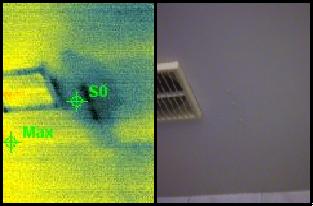The longer the leaky home crises goes on, the more I see plaster home owners getting pushed down into a hole by some inspection companies… even if their home isn’t leaking!
Why do I bring this topic up?
Let me start by saying a thermal imaging camera is accurate and doesn’t lie… it is what it is. But, the interpretation by the thermographer of what the infrared camera is actually seeing can vary wildly.
‘Suspicious’ patterns in a thermal camera could simply mean the insulation isn’t pushed into the corners correctly, or maybe there’s been a wind draft through the roof space that has slightly lifted the batts up off the gib… but hardly a deal breaker!
If an anomaly appears on the camera screen, then further confirmation is required (Some companies may not do invasive testing)… but accurate thermal imaging inspections go beyond what the camera says.
Here’s what a ‘clean’ thermal image looks like…
Notice the nice clean lines on the ceiling?
This is a ‘not so good’ thermal photo…
The ‘thermal anomaly’ to the left is a leak from a shower above that clearly can not be seen on the ceiling in the right hand photo (as the human eye would see it).
What’s really behind the walls in the home you’re looking to purchase? Are you 110% sure? Most of the leaks we’ve detected in NZ houses showed no visual evidence of a problem before we infrared imaged the property!
Every home is a good deal at the right price, regardless of how many problems are found… so get it tested and negotiate the price accordingly. People buy leaky buildings for the price of the dirt!
How can you seriously negotiate a property contract unless you base your offer on FACTS… not what the GV says, or what the agent tells you. It’s up to you to find out the true condition of the property… and you only, because no-one is going to do it for you. You’ve got big $$$ on the line when buying a house, so do your research correctly, and don’t fall into the ‘dumb purchaser who didn’t do their homework first’ category. I witness this scenario all the time with novice investors and first home buyers!
Hopefully this info above gets you thinking on the right track before signing the dotted line.








